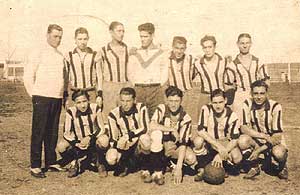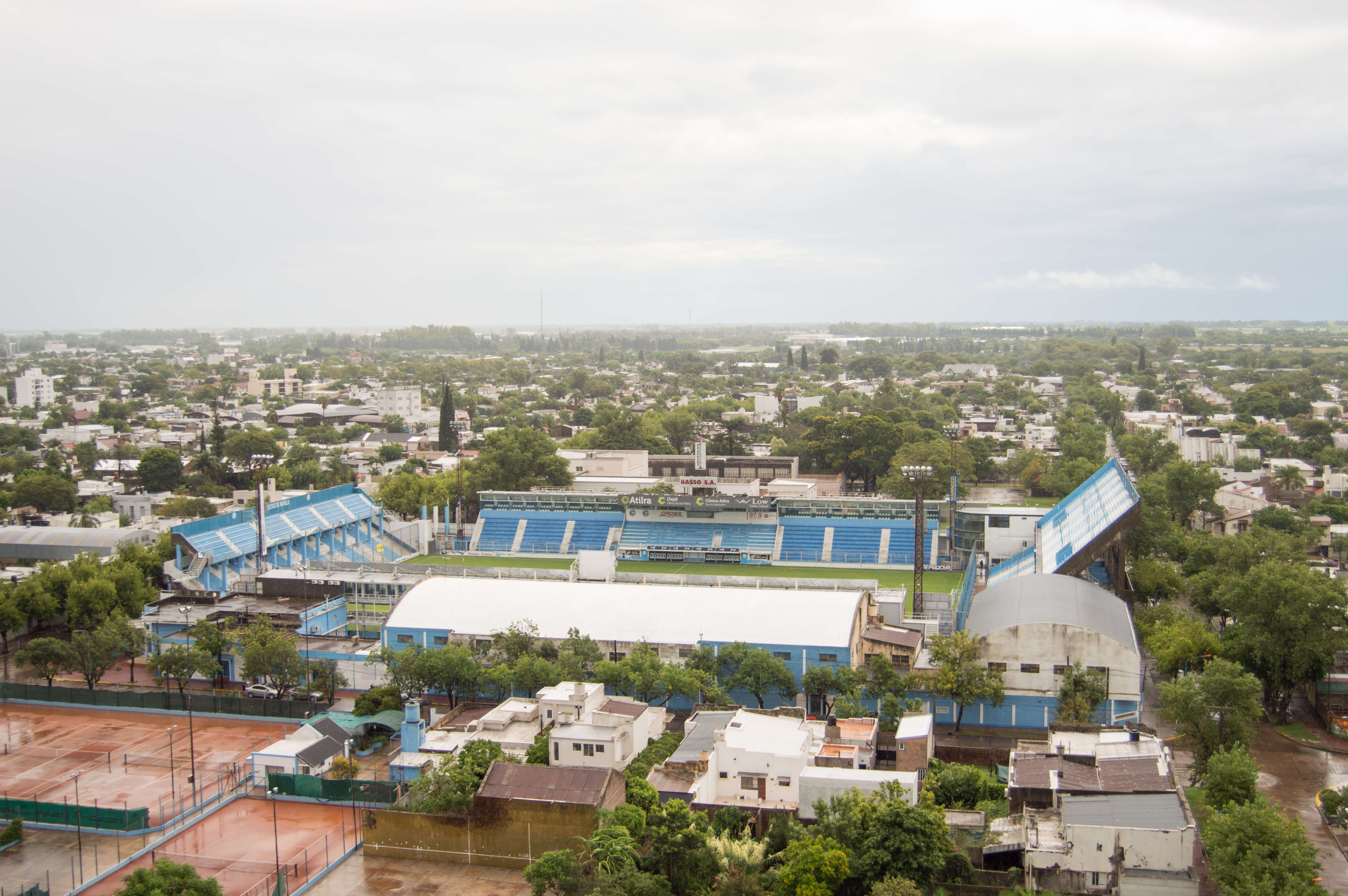|
2006–07 Primera B Nacional
The 2006–07 Argentine Primera B Nacional was the 21st season of second division professional of football in Argentina. A total of 20 teams competed; the champion and runner-up were promoted to Argentine Primera División. Club information Torneo Apertura standings Torneo Clausura standings Overall standings Promotion playoff This leg was played between the Apertura and the Clausura winner, but as Club Olimpo, Olimpo won both tournaments, was declared champion and was automatically promoted to 2007–08 Argentine Primera División, 2007–08 Primera División, so the match was played between the best teams placed in the overall standings under Club Olimpo, Olimpo, San Martín de San Juan, San Martín (SJ) and Club Atlético Huracán, Huracán. The winning team was promoted to 2007–08 Argentine Primera División, 2007–08 Primera División and the losing team played the 2006–07 Primera B Nacional#Promotion Playoff Primera División-Primera B Nacional, Promotion Playo ... [...More Info...] [...Related Items...] OR: [Wikipedia] [Google] [Baidu] |
Argentine Primera B Nacional
Primera Nacional (usually called simply Nacional B, in English "National B Division", and known as Primera B Nacional until the 2019–20 season) is the second division of the Argentine football league system. The competition is made up of 37 teams. It is played by teams from all over the country. Clubs from Buenos Aires surroundings, as well as some from Santa Fe Province, are promoted from or relegated to the Primera B Metropolitana ("Metropolitan B Division") while for teams from the other provinces the Torneo Federal A ("Federal A Tournament") is the next level down. In Argentine football, Nacional B is the second-highest league, and from it, the three best teams are automatically promoted to Primera División. Primera B Nacional games are often transmitted to Argentina and abroad on television by TyC Sports. History It was created in 1986 to integrate unaffiliated clubs into the Argentine football structure, which until then had only participated in Nacional championships o ... [...More Info...] [...Related Items...] OR: [Wikipedia] [Google] [Baidu] |
Club Almagro
Club Almagro is an Argentine sports club from José Ingenieros, Buenos Aires, although its headquarters are in the Almagro district. The football team currently plays in the Primera Nacional, the second division of the Argentine football league system. History Almagro was founded on January 6, 1911, in the Almagro neighbourhood of Buenos Aires. The club still has its sports facilities there for its members, but the football stadium (with a capacity of 19,000) is located in José Ingenieros, in the Tres de Febrero Partido of Greater Buenos Aires. In 1919 there was a new splitting in Argentine football, so both leagues were played at the same time: official Asociación Argentina de Football (with one of Almagro predecessors, Columbian, as one of its teams) and dissident "Asociación Amateurs de Football". During that season, Columbian was going through a severe economic crisis, disputing its last game v. Boca Juniors in the 6th fixture. Some executives of recently promoted ... [...More Info...] [...Related Items...] OR: [Wikipedia] [Google] [Baidu] |
Chacarita Juniors Stadium
Club Atlético Chacarita Juniors (usually known simply as Chacarita) is an Argentine football club headquartered in Villa Crespo, Buenos Aires, while the stadium is located in Villa Maipú, General San Martín Partido of Greater Buenos Aires. The squad currently plays in Primera Nacional, the second division of the Argentine football league system. History The club was founded on 1 May 1906, in an anarchist Library on the boundary between the Villa Crespo and Chacarita, Buenos Aires, Chacarita neighbourhoods. After a short period of institutional crisis, the club was re-opened in 1919. The football squad promoted to Argentine Primera División, Primera División in 1924, and continued playing at the top level after football became professional in 1931. In 1940 Chacarita was relegated to the second division, but it lasted only one season. The team then moved to the General San Martín Partido in Greater Buenos Aires, next to the autonomous city of Buenos Aires. In 1956 Chaca ... [...More Info...] [...Related Items...] OR: [Wikipedia] [Google] [Baidu] |
Villa Maipú
Villa Maipú is a ''localidad'' (district) of the General San Martín Partido in Buenos Aires Province, Argentina. It forms part of the urban agglomeration of Greater Buenos Aires. The ''localidad'' is home to Chacarita Juniors, a football club that won the 1969 Metropolitano Metropolitano S.A. was a privately owned consortium formed in 1994 to take over concessions granted by the Argentine government as part of railway privatisation during the presidency of Carlos Menem for the operation of commuter rail services i .... External links * * Populated places in Buenos Aires Province General San Martín Partido {{BuenosAiresAR-geo-stub ... [...More Info...] [...Related Items...] OR: [Wikipedia] [Google] [Baidu] |
Chacarita Juniors
Club Atlético Chacarita Juniors (usually known simply as Chacarita) is an Argentine football club headquartered in Villa Crespo, Buenos Aires, while the stadium is located in Villa Maipú, General San Martín Partido of Greater Buenos Aires. The squad currently plays in Primera Nacional, the second division of the Argentine football league system. History The club was founded on 1 May 1906, in an anarchist Library on the boundary between the Villa Crespo and Chacarita neighbourhoods. After a short period of institutional crisis, the club was re-opened in 1919. The football squad promoted to Primera División in 1924, and continued playing at the top level after football became professional in 1931. In 1940 Chacarita was relegated to the second division, but it lasted only one season. The team then moved to the General San Martín Partido in Greater Buenos Aires, next to the autonomous city of Buenos Aires. In 1956 Chacarita was relegated to the second division again, ... [...More Info...] [...Related Items...] OR: [Wikipedia] [Google] [Baidu] |
Estadio Municipal De Comodoro Rivadavia
Estadio Municipal de Comodoro Rivadavia is a multi-use stadium in Comodoro Rivadavia, Argentina. It is primarily used for football Football is a family of team sports that involve, to varying degrees, kicking a ball to score a goal. Unqualified, the word ''football'' normally means the form of football that is the most popular where the word is used. Sports commonly c ... and is currently the home ground for Comisión de Actividades Infantiles Comodoro Rivadavia (C.A.I.). The stadium holds 10,000 people and was built in 1975. Sports venues in Argentina Comisión de Actividades Infantiles Municipal de Comodoro Rivadavia {{Argentina-sports-venue-stub ... [...More Info...] [...Related Items...] OR: [Wikipedia] [Google] [Baidu] |
Comodoro Rivadavia
Comodoro Rivadavia () is a city in the Patagonian province of Chubut in southern Argentina, located on the San Jorge Gulf, an inlet of the Atlantic Ocean, at the foot of the Chenque Hill. Comodoro Rivadavia is the most important city of the San Jorge Basin, and is the largest city in Chubut as well as the largest city south of the southern 45th parallel. The city is often referred to simply as ''Comodoro''. It was at one time the capital of the Comodoro Rivadavia Territory, which existed from 1943 to 1955. The territory was a part of Chubut before and after its creation, and the city became the capital of the Escalante Department. It had a population of 137,061 at the , and grew to 182,631 by the 2010 census. Comodoro Rivadavia is a commercial and transportation center for the surrounding region, the largest city of Chubut, and an important export point for a leading Argentine petroleum district. A 1,770 km pipeline conveys natural gas from Comodoro Rivadavia to Buenos Aire ... [...More Info...] [...Related Items...] OR: [Wikipedia] [Google] [Baidu] |
Comisión De Actividades Infantiles
Comisión de Actividades Infantiles (English: ''Committee on Children's Activities''), also known simply as CAI, is an Argentine football club located in the city of Comodoro Rivadavia, of Chubut Province. The team plays in Torneo Argentino A. The club was founded on 1 January 1984, as a sports club for young people, though by 1989 the activity focused only on football. The team currently plays in the Primera B division of the Argentine league (which is equivalent to the second division). Home games are played at the Estadio Municipal de Comodoro Rivadavia, which has a capacity of approximately 10,000 seats. The club focuses primarily on the development of players from its youth divisions. Current squad As of November 2017. at BDFA |
Estadio Parque Barrio Ilolay
Estadio Parque Barrio Ilolay is a multi-use stadium in Rafaela, Argentina. It is currently used primarily for football matches by Club Sportivo Ben Hur Club Sportivo Ben Hur is an Argentine sports club from Rafaela, Santa Fe Province. The club was founded in 1940 and is mostly known for its basketball and football teams. Other sports practised in the club are aerobics, bowls, chess, field hock .... The stadium has a capacity of 12,000 people. References parque {{Argentina-sports-venue-stub ... [...More Info...] [...Related Items...] OR: [Wikipedia] [Google] [Baidu] |
Club Sportivo Ben Hur
Club Sportivo Ben Hur is an Argentine sports club from Rafaela, Santa Fe Province. The club was founded in 1940 and is mostly known for its basketball and football teams. Other sports practised in the club are aerobics, bowls, chess, field hockey, and swimming. Basketball Basketball is the sport that gave the most important successes to the club, winning the 2004–05 national championship, and the Liga Sudamericana 2006 among other titles. The club's in-doors arena is the Coliseo del Sur. Titles *Liga Nacional de Básquet: 1 :2004–05 *Liga Sudamericana: 1 :2006 *Torneo Nacional de Ascenso: 1 :2001–02 *Liga Federativa C: 1 :1994–95 Football Football has been the main activity of the club since its foundation, although Ben Hur has achieved important titles in basketball as well. In its early years, Ben Hur started playing in the local league of Rafaela, but it was not until 1997 when Ben Hur left the regional tournaments to join the Argentine Football Association. The club ... [...More Info...] [...Related Items...] OR: [Wikipedia] [Google] [Baidu] |
Estadio Nuevo Monumental
Estadio Nuevo Monumental is a stadium in Rafaela, Argentina. It is the home ground of Atlético de Rafaela. The stadium was opened in 1954, and has a capacity of 16,000. References {{coord, 31, 15, 03, S, 61, 28, 53, W, display=title, region:AR-S_type:city(82000)_source:dewiki Atlético de Rafaela Sports venues in Argentina Football venues in Argentina, Rafaela 1954 establishments in Argentina ... [...More Info...] [...Related Items...] OR: [Wikipedia] [Google] [Baidu] |
Rafaela
Rafaela () is a city in the province of Santa Fe, Argentina, about 96 km from the provincial capital. It is the head town of the Castellanos Department. It has a population of 99,150 per the . The city was established in 1881 by Guillermo Lehmann, and officially became a city in 1913. The city has grown 22.2% between 1991 and 2001, and 18.6% in the last census period (2001-2011) according to the official data of the Population Census (INDEC). The city is almost the exact antipode of Wuhu in China. The city hosts Rafaela Aerodrome airport and the Autódromo Ciudad de Rafaela race track. Zoning of the city The city is located in the western-center area of Santa Fe Province and has an area of . The design of most of the urban area of the city has a shape of a checkerboard with the main plaza (Plaza 25 de mayo) in the middle of the city and four main boulevards coming from there. The street grid of the city is composed by square blocks in most part of the neighborhoods, mai ... [...More Info...] [...Related Items...] OR: [Wikipedia] [Google] [Baidu] |






